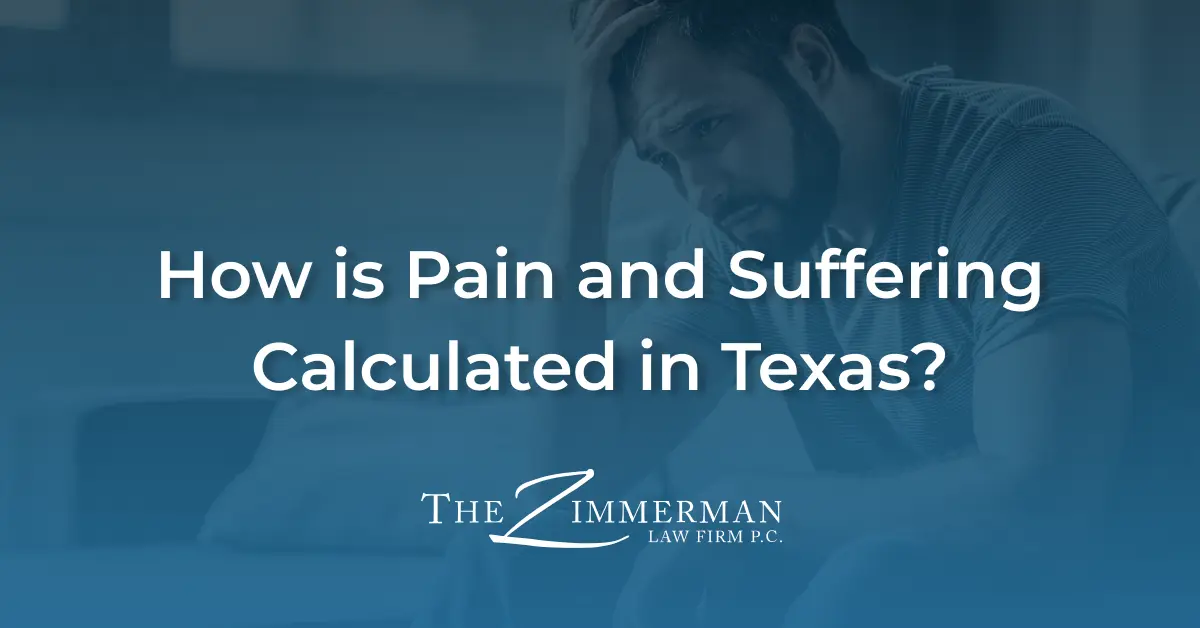 Lesiones
Lesiones
Pain and suffering is an important subcategory of general damages in any personal injury case.
However, determining how much pain and suffering is worth in a Texas claim can be challenging.
One reason is that non-economic damages are not easily quantifiable as tangible economic losses like medical expenses and lost wages.
Understandably, prospective clients want to know, How is pain and suffering calculated in Texas?
To accurately determine a value for your specific case, speak with a professional San Antonio personal injury attorney at the Zimmerman Law Firm today.
Damages Covered Under Pain and Suffering in a Texas Personal Injury Claim
Before calculating a figure, it’s crucial to understand what makes up pain and suffering in a personal injury claim. Examples of pain and suffering include:
- Physical pain and suffering, including chronic pain complaints;
- Permanent damage that results in losing an important bodily function;
- Post-traumatic stress disorder (PTSD) and other psychological trauma;
- Permanent scarring, disability, or disfigurement;
- Pérdida de consorcio;
- Angustia emocional;
- Anxiety and depression; and
- Loss of enjoyment of life or diminished quality of life.
Pain and suffering values will be higher for victims who have severe injuries. Cases involving catastrophic injuries or wrongful death claims have the highest value.
For example, if a plaintiff had minor injuries that resolved in two or three months they would not have the same pain and suffering as someone who has lost the use of their leg.
Calculating Pain and Suffering
There is no pain and suffering calculator in Texas that every adjuster or jury uses when evaluating your claim’s value.
However, two popular calculation methods are often used when calculating a fair value for pain and suffering at trial.
The first is the multiplier method. This method starts with calculating your total amount of economic damages.
Your economic damages are quantifiable losses, such as your medical expenses, property damage, lost wages, etc.
Then, the jury might multiply that total amount by a specific number, usually somewhere between 1.5 and five. The worse your injuries are, the higher the multiplier.
For example, take a plaintiff with $20,000 in economic damages. Using a multiplier of two, pain and suffering damages would be $40,000.
For someone with permanent injuries, a jury might use a multiplier of five. Then the total amount for pain and suffering would be $100,000.
The second method is based on the per diem method. This calculation method assigns a specific dollar amount to every day you are healing from your injuries.
A common dollar amount is what you would typically receive from your salary for that day. You would receive this amount for each day until you reach a point of maximum medical improvement (MMI).
If someone took 50 days to reach MMI, and they made $100 per day on average, pain and suffering might be $5,000 in this case.
Juries often lean toward the per diem method for cases where the plaintiff has a recovery date.
In contrast, the multiplier method may be a more common option for cases involving long-term injuries or permanent damage.
How Claims Adjusters Value Pain and Suffering
You might be wondering how claims adjusters calculate pain and suffering if your case doesn’t go to trial.
Depending on the company, they may have claims software programs, such as Mitchell, Colossus, or Claims Outcome Advisor.
These programs are popular for minor injury claims, especially soft tissue injuries.
The adjuster may be prohibited from extending an offer that falls outside of the software’s suggested range unless you can bring them “new” information that changes the value.
Adjusters enter injury codes, medical billing codes, and other information so the program can calculate an acceptable settlement range.
Insurance companies minimize your medical expenses, and then using the software can be a way to reduce their potential payout.
Most claims software programs severely undervalue general damages, which is why jury verdicts are often significantly higher.
Insurance adjusters rely on the fact that you don’t handle claims for a living, so you may not realize how low their offer is.
Retaining a skilled San Antonio personal injury attorney can eliminate this problem.
What Can I Claim for Pain and Suffering Damages in Texas?
In Texas, pain and suffering damages can include several elements. Common pain and suffering claims include claims for:
- Physical pain and suffering,
- Angustia mental,
- Angustia emocional,
- Permanent disfigurement or scarring,
- Permanent loss of bodily function,
- Post-traumatic stress disorder (PTSD),
- Loss of consortium, and
- Loss of enjoyment of life.
This list is not exhaustive, and the damages you may be entitled to will be unique to your case.
Factors That Impact Pain and Suffering
Pain and suffering is a very subjective value. You are likely to place a higher value on your own pain because you are living it, and it’s personal.
A jury will look at a variety of factors when determining what method or multiplier to use.
Some of these factors include:
- The nature of your injuries;
- The severity of your injuries;
- How your injuries impact your life now;
- How your injuries will impact your future;
- Your age, health before the accident, income level; and
- How your injuries affect your family life.
To maximize your value for pain and suffering, it’s a good idea to keep a journal where you log your pain and detail how your injuries impact your life.
It will make it easier when you’re preparing for a deposition or testimony at trial.
Texas caps general damages in certain instances, such as in medical malpractice cases.
Special cases involving malicious intent or gross negligence could be eligible for punitive damages. Those damages are also capped in Texas unless the injuries resulted from a felony.
Injured? Contact a Texas Personal Injury Lawyer
Wondering how pain and suffering damages are calculated in your injury claim? Trust the Zimmerman Law Firm. Our Texas injury lawyers will assess your case and advocate for maximum compensation.
If you need assistance resolving a personal injury claim in Texas, contact us at 254-752-9688.
With years of experience handling San Antonio personal injury claims, we’re well-versed in insurance companies’ tactics to undervalue claims.
Let us help you counter these tactics and build a strong case for pain and suffering damages. Schedule a free consultation with the Zimmerman Law Firm today.


